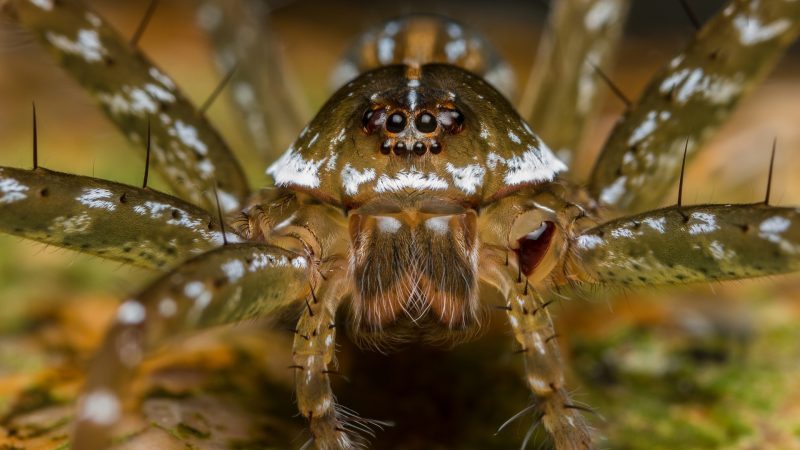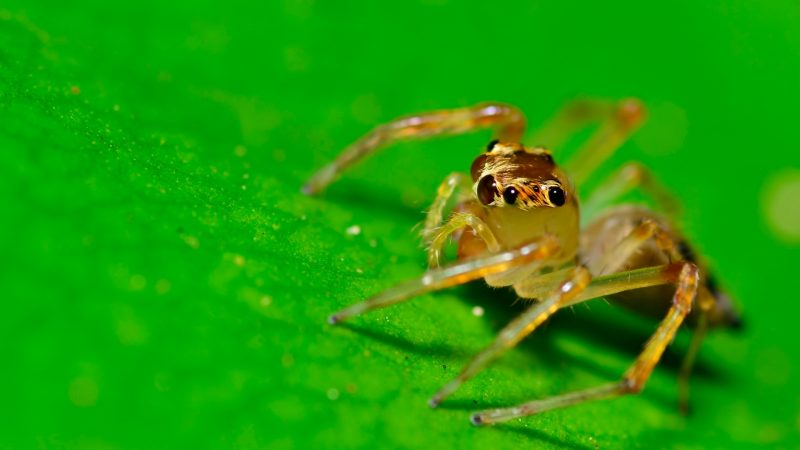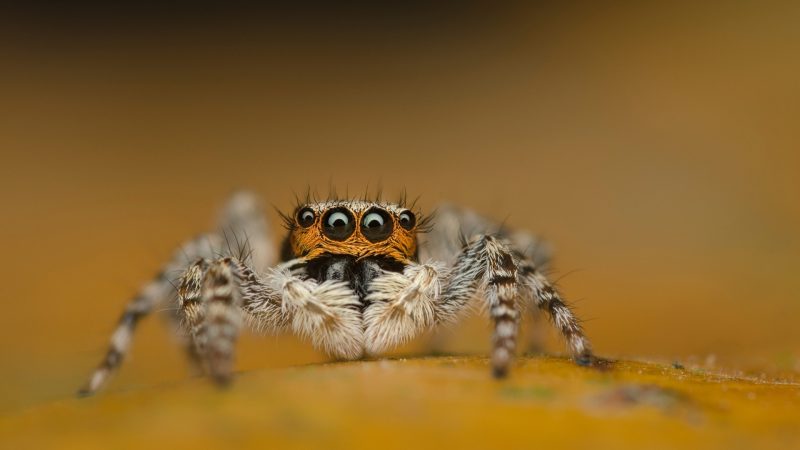There are over 300 types of jumping spiders in the USA, and each species comes in different colors and sizes. As their name suggests, they are excellent jumpers, and they can jump 10 to 40 times their body’s length. Jumping spiders use this power to jump on and bite their prey, but what happens if they accidentally bite a human instead – are they dangerous?
Are jumping spider bites dangerous? Jumping spider bites are not dangerous. They only bite when they are physically threatened. If they bite you, it may hurt and break the skin, but these spiders are not harmful to humans, so you shouldn’t worry.
This article will talk more about jumping spider bites and what you should do if one of these spiders bites you. We’ll also help you determine whether a bite is from a jumping spider or not and offer you some ways to treat and soothe the bite.
Do Jumping Spiders Bite?

Jumping spiders do bite, and that is how they kill other insects for food. Still, they only bite people when a human threatens to crush them, when people invade their homes, or when they are afraid.
Jumping spiders do not spin webs to catch food. Instead, they spin one single thread they use to lower themselves onto their prey. This thread protects the spider, much like a mountain climbing rope, and once they are near their victim, they quickly jump on it and bite it.
Related: Can Spiders Bite Through Leggings?
Are Jumping Spiders Dangerous to Humans?
According to experts at Michigan State University, many dermatologists believe that jumping spiders are the most common biting spiders in the USA.
The carnivorous jumping spiders are not dangerous to humans, though, and they are never aggressive. Additionally, some jumping spiders are omnivores, and they feed on nectar and flower pollen. One known species, Bagheera Kiplingi, only eats nectar.
Moreover, jumping spiders are terrified of humans. They have excellent vision, so they never seek out a human to bite. Most jumping spider bites happen by accident when people accidentally corner or trap the spider.
Related: Are Daddy Longlegs Dangerous?
What Does a Jumping Spider Bite Look Like?

A jumping spider bite looks like a mosquito bite in most cases – red and itchy, but painful, though bites can appear differently on different people. At times, you can see two dots where the spider bit you, which are tiny puncture marks made by the spider’s fangs when they punctured your skin.
However, the puncture marks are so small that they are not visible in most cases. Several hours after being bitten, the puncture marks may swell and itch, but not excessively.
Within 72 hours, the bite usually heals and leaves no lasting mark.
Jumping Spider Bite Symptoms
The symptoms of jumping spider bites include an itchy, stinging red welt. People allergic to a jumping spider’s bite may experience nausea, dizziness, a spreading rash, or a fever. Still, rarely, some people are allergic to jumping spiders.
Most people get worried when a jumping spider bites them as they don’t know what to expect. Luckily, no jumping spider has harmful venom, and the pain is usually less than that of a bee sting, so you won’t have to worry too much.
However, it’s advisable to see a doctor if you suspect that a jumping spider has bitten you.
What Causes a Jumping Spider to Bite You?
If a jumping spider bites you, you have likely scared it. Jumping spiders usually avoid people at all costs. Still, if you startle one, accidentally trap or corner it, or accidentally reach into its home, it may bite you in an attempt to protect itself.
Usually, if you have a jumping spider bite, you shouldn’t worry. Jumping spiders are venomous, but their venom is of no medical importance. That means jumping spider venom doesn’t work on humans- it only works on tiny insects like ants, crickets, flies, and grasshoppers.
The bite will sting for a while, but all symptoms usually subside within a week at most.
Are Jumping Spider Bites Painful?
Jumping spider bites is painful, and the amount of pain will be different depending on several factors. Sometimes, when a spider bites, it won’t inject any venom at all. If the spider does not inject any venom into your skin, the bite will probably feel like an ant or ladybug bite.
If the spider has time to inject venom, it probably will. Jumping spiders are scared of people, and if they get on you and can’t get away, they will probably bite you so that you brush them off of your body. When the spider injects venom, you can expect a stinging sensation, like a localized sunburn. Sometimes, the bite may throb, and it will likely swell later.
Now, if a jumping spider gets stuck in your clothes, or if you trap it in your hands, you can expect a more painful bite. If the spider feels like you are about to kill it, it will inject more venom in an attempt to escape. These bites may burn a little extra and last longer than other jumping spider bites, but you need not worry about them in most cases.
Are Jumping Spider Bites Poisonous?
The subtle and clever arachnids of the world have developed a variety of cunning venoms over thousands of years. Jumping spiders don’t usually prey on humans; they typically only hunt insects.
So, jumping spiders may have venom, but their bites are not poisonous unless you have an allergy to jumping spiders. Additionally, their venom may be lethal to some small insects, but it is pretty harmless to humans.
Do Jumping Spider Bites Itch?
Jumping spider bites may itch if it injects venom into your skin. Usually, the sensation is much like a mosquito bite, and it should subside within a few days. Still, it will take up to a week for the itching to go away in some cases.
If your jumping spider bite itches, you should avoid scratching it. Since the venom will spread as you put pressure on the bite, the more you scratch the spot, the itchier it will become. So, if it’s unbearable, reach for an anti-itch cream before you scratch.
Allergic Reactions to Jumping Spider Bite
In rare cases, people have been known to be allergic to jumping spiders. Jumping spider allergies are very rare, but the most common symptoms include:
- Dizziness
- Nausea
- A spreading rash around the bite
- Fever
- Throbbing pain at the bite
- Swollen lymph glands
- Trouble breathing (a sign of anaphylactic shock)
If you experience any of these symptoms after being bit by a spider, call a doctor.
Jumping Spider Bite Treatment
If a spider bites you, you will need to disinfect the bite to avoid infection. Optionally, suppose you want to reduce the swelling and pain. In that case, you can use several other methods to reduce your body’s inflammatory response.
If a jumping spider bites, you use an antibiotic ointment, antihistamines, and cold compresses to reduce the swelling.
So, let’s go through the steps in detail so that your spider bite goes away quickly.
Related: How To Use Vinegar To Get Rid of Spiders?
How To Treat a Jumping Spider Bite?
Important: Before using the following products, it’s recommended to consult with your doctor.
To treat a jumping spider bite:
Step 1: Wash the bite with gentle soap and water to prevent the chances of an infection.
Step 2: Optionally, apply a bit of antibacterial ointment, cortisol cream, or an antihistamine to prevent swelling and itching.
Step 3: To reduce itching and swelling, take an antihistamine or an anti-inflammatory medication like Benadryl, acetaminophen, or ibuprofen.
Step 4: Apply ice or a cool, damp cloth to the bite to reduce swelling.
What To Use To Treat Jumping Spider Bites?

You can treat jumping spider bites using an ointment or relief gel. There are many good products available online or at your local pharmacies for reducing pain, itching, and swelling caused by jumping spider bites and other spiders.
Still, there are a few things to note before you treat your bite. First, don’t take more than one over-the-counter medication at a time, and always follow the directions printed on the label. Also, some medicines can react with other prescription medications, so you should only take over-the-counter medications approved by your doctor if you are taking a prescription drug.
Some of the best treatments on Amazon for spider bites are:
- Neosporin Antibiotic Ointment to reduce the chances of infection.
- .5 ounces of Neosporin Original First Aid Triple Antibiotic...
- Wound care ointment is formulated with the triple antibiotic...
- Antibiotic ointment contains unique HeliDerm Technology which...
- First aid essential in a compact and portable .5-ounce tube,...
- To use, clean affected area with a BAND-AID Brand Antiseptic...
- Benadryl Extra Strength Relief Stick to reduce itching and inflammation.
- 4 .47-fluid ounce sticks of Benadryl anti-itch relief formula to...
- Biofreeze Pain Relief Gel to reduce swelling, cool the bite, and reduce pain.
- #1 Clinically Recommended Menthol Topical Pain Relief Brand
- This 3 fl oz gel tube is one of the most popular formats,...
- Biofreeze is a clinically recommended brand; trusted by...
- Product is not tested on animals, made with USP grade menthol,...
- Product is not tested on animals, made with USP grade menthol,...
- Benadryl Ultratabs Antihistamine reduces allergic reactions, minimizes swelling, and relieves pain.
- Multi-Symptom Relief: Small coated Benadryl Ultratabs with 25 mg...
- Portable Allergy Medicine: The convenient 100-count bottle fits...
- Versatile Allergy & Cold Relief: Antihistamine tablets...
- Active Ingredient & Age Guidance: Each Benadryl Ultratab contains...
- Value Pack Supply: 100-count package of allergy relief tablets...
Related: Will Ant Spray Kill Spiders?
List of Sources
Jensen, M. (2009). Herbivory Discovered in a Spider. The University of Arizona News.
College of Letters and Science Field Station. (2010). Jumping Spider (Family Salticidae). University of Wisconsin-Milwaukee.
Watt, A. (2020). Our Venomous Neighbours. University of Melbourne School of Biomedical Sciences.
Knight, K. (2001). Phidippus audax. Animal Diversity Web.
- How to Get Rid of Copperheads | Practical Guide - August 27, 2023
- How to Get Rid of Corn Snakes | What Makes Them Aggressive? - August 27, 2023
- How to Get Rid of Alligators | Safety Measures and Removal Methods - July 16, 2023




